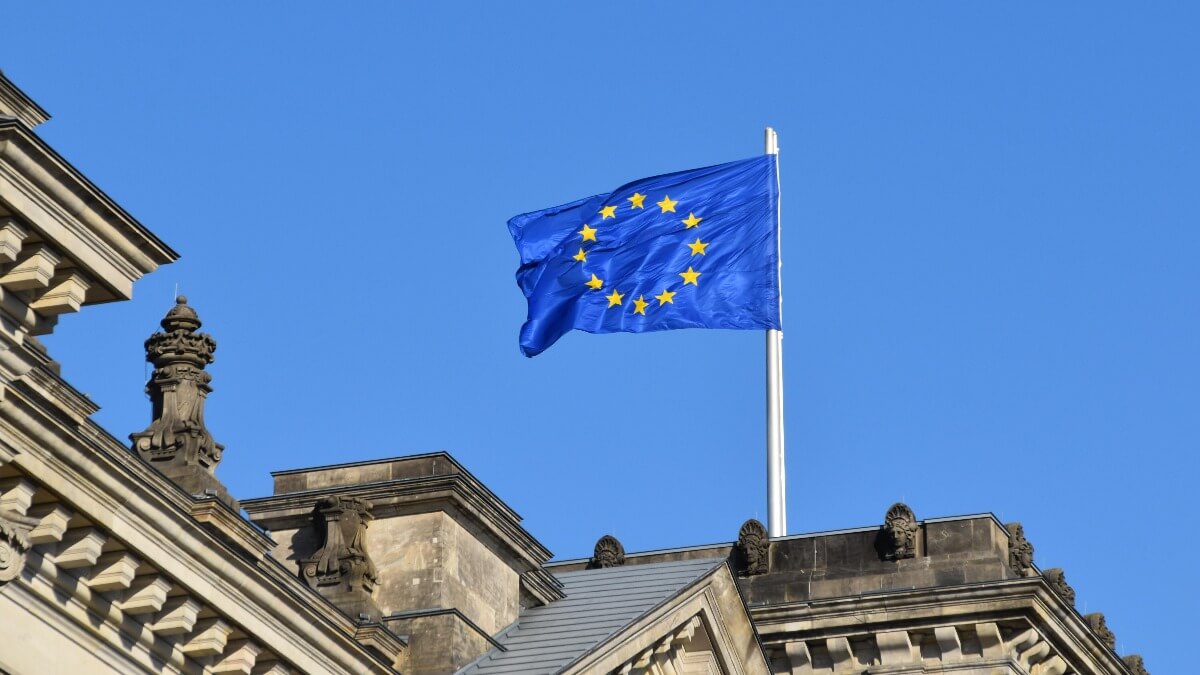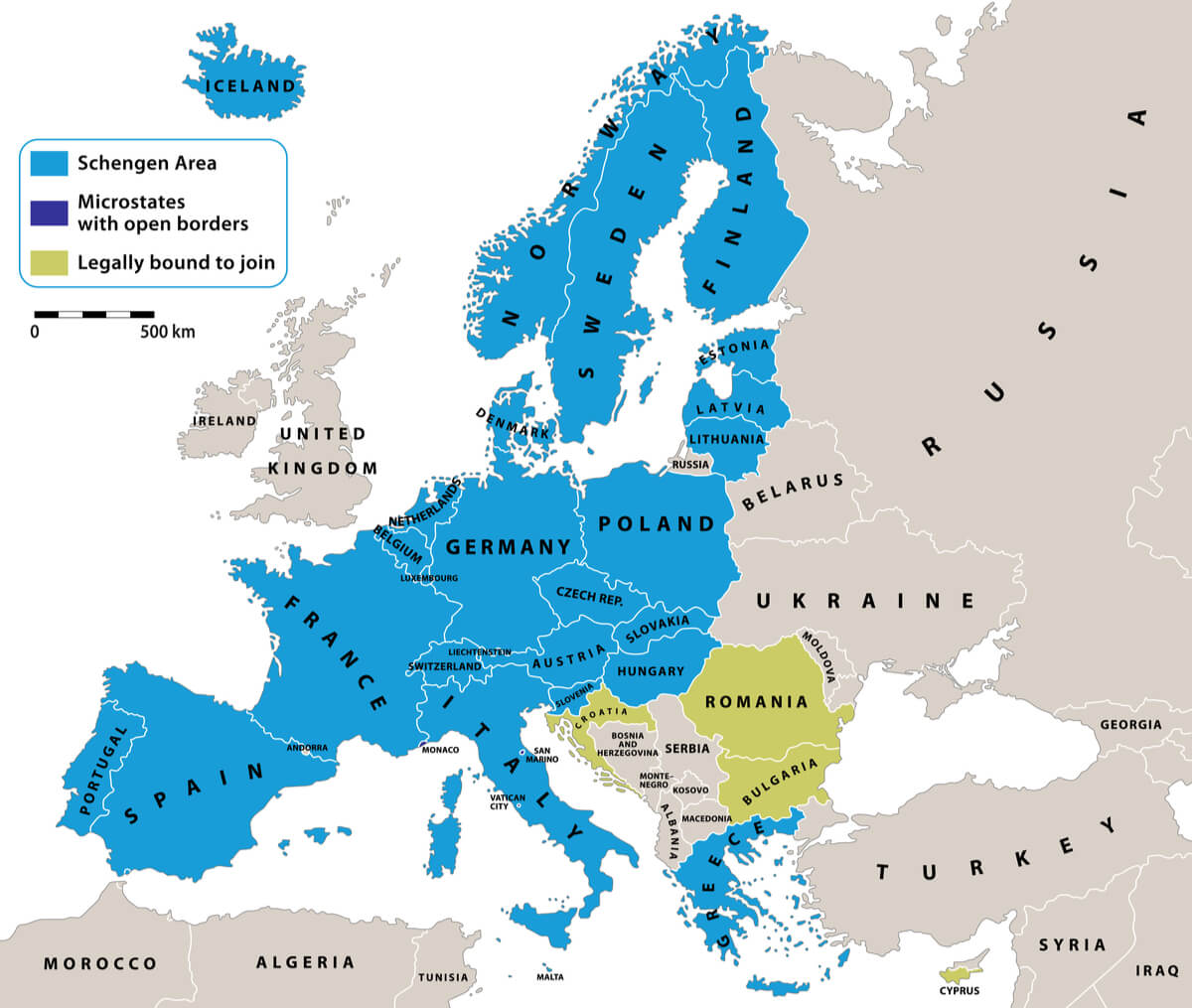The ultimate international summer camp guide
Everything you need to know about international summer camps.

If you’re considering a trip to Europe, you’ll want to know about the European Schengen Area.
The 26 Schengen area countries work together to allow border free travel within their region. That means no need to wait at border checkpoints when you travel, no new visas or permits for a multi-city trip, and no restrictions to access across states. The Schengen area was started by the European Union, with the aim of allowing freedom of movement for EU citizens, residents and travelers. This guide covers what it means, and how it can help visitors headed to Europe to see more and do more on their trip.
| 📑 Table of Contents |
|---|
We’ll also touch on the Wise Multi-currency Account as a handy tool for your travels to Europe. Hold, send, and spend dozens of currencies using the same account — and get a linked debit card for fee free spending and ATM withdrawals all over the world. More on that later.
The European Schengen area is designed to allow border-free travel for EU citizens, residents and visitors with the correct visa permissions¹. Initiated by the European Union back in the 1980s, the Schengen area today can boast pretty frictionless travel for all, across much of Europe — making life much easier for visitors and cross border commuters.
Within the Schengen area there are effectively no border controls.
If you’re entitled to live and work in the EU you can usually travel, live and work freely within this area without needing to get new permits or even show your passport.
Travelers in the Schengen area who have visa waivers — like most US citizens on short trips — won’t need to stop at border controls to move from one state to another.
And even if you’re a traveler in Europe and you do require a visa, you’ll be able to plan a multi-destination trip with a single Schengen visa.
At the time of writing there are 26 countries in the Schengen area, with more working on joining the group. It’s important to remember that not all EU member states are in the Schengen area, while some countries which are not full members of the EU are actually Schengen states. We’ll cover that in more detail later.
Managing and maintaining the Schengen area relies on several broad reaching cooperations between member states, backed by information sharing and technology. Systems used include:
|
|---|
So what are the real life implications of the Schengen area — either as a citizen, resident or visitor?
For EU citizens and legal residents, the Schengen area gives people the opportunity to live and work without restrictions within the 26 countries. This is especially useful where cross border commuting is commonplace. For example, many people working in Switzerland actually live over the borders in France or Germany. According to some figures, 320,000 cross border commuters head to jobs in Switzerland every day — 6% of all employees, and up to 25% in border regions⁵.
If you’re a traveler in Europe, the Schengen agreement means that you can much more easily visit different countries and cities — without wasting time on border checks. Travel times in Europe are often tiny in comparison to getting from one city to another in the US, so skipping the passport controls as you hit the highlights of Europe makes the whole thing even more convenient.
Let’s look at the essentials of the Schengen agreement, and how it works in practice:
| 💡 Essential features of the Schengen Zone¹ |
|---|
|
Schengen is the name of the village in Luxembourg where the agreements to work towards freedom of movement within the European Union were first signed in 1985¹.
Although the EU had aimed for frictionless travel for some time, the significance of the breakthrough made in Schengen eventually led to the full convention being signed in 1990, and then initiated in 1995 — and gave the border-free region its name in the process.
Countries may be members of the EU but not in the Schengen area. They may also be in the Schengen agreement but not in the EU.
Acceptance into the Schengen area relies on countries being able to fully comply with the Schengen agreements, including following common visa rules, and cooperating fully over border security measures. At present, some EU countries like Bulgaria and Romania are not yet fully within Schengen — although they’re working towards this status. However, non-EU countries which comply with the Schengen protocols, like Iceland and Norway, are already part of the Schengen area, even though they’re not in the European Union.
The UK is neither in the EU nor part of Schengen. Even when the UK was part of the European Union, prior to Brexit, it was not part of the Schengen area.
The UK — along with Ireland — had opted out of joining the shared border agreement when it joined the EU originally. The UK does actually have a common travel area with Ireland, which allows for some freedom of movement between the two countries, but operates its own border rules, checks and controls for all points of entry.
Within the Schengen area there are no regular border controls. That means you can normally simply drive over the border from one Schengen country to another without showing your passport or acquiring a new visa. Instead, travelers apply for a Schengen visa which allows for free travel within the Schengen area for up to 90 days⁶. This visa is checked at the point of arrival into the Schengen area, with all participating countries cooperating to ensure that the outer borders are controlled.
It’s worth noting that the Schengen provisions do allow for some forms of border check by police, and in the event of emergency situations. Therefore, although you can theoretically leave your passport at home when you head out on a cross border trip within Schengen, it’s not a smart idea to do so.

The Schengen area currently comprises of 26 countries:
|
|
|---|
It’s important to know that not all European countries — and not even all countries within the EU — are part of the Schengen area. Some countries are actively working towards joining Schengen, but others have for a long time opted to maintain their own border controls outside of this protocol. If you’re taking a multi-destination trip to Europe you’ll need to check you have the correct visas for all the places you intend to visit.
Notable European countries which are not Schengen states include:
|
|---|
Some countries which are not part of the European Union are actually part of the Schengen area — these include Switzerland, Norway and Iceland.
Joining the Schengen area requires states to meet a series of eligibility criteria. Some countries within the EU are currently working on these with a view to joining the Schengen area later, including Bulgaria, Croatia and Romania. You may find that when you travel through these countries, some aspects of the Schengen protocols are already in place.
US passport holders don’t usually need a visa to enter the Schengen area for a short stay. However, it’s worth checking the exact rules based on your situation and planned trip.
If you’re in the US as a Green Card holder for example, and your original home country does not have a visa waiver arrangement with your destination, you may still need a Schengen visa.
Schengen visas are typically issued for a stay of up to 90 days in any 180 day period, and allow for free movement through the Schengen states. You’ll have to apply for your Schengen visa at the consulate of the country where you’ll spend the longest time on your trip⁷. If your stay in the Schengen area will be split between several countries equally, you’ll have to apply for your visa at the consulate of the one you’ll visit first.
| Learn more about Schengen visas — including who needs one, and how to get one — here |
|---|
The Schengen area borders are secured through checks on entry at external borders, and at standard points of entry for travelers like international airports. That means that most people traveling to the Schengen area will need to present their travel document and any required visa upon arrival at a Schengen state, but are unlikely to be asked again as they travel from one Schengen area country to another.
The Schengen protocols do allow for temporary reintroduction of border measures if there’s an emergency situation, and for some police checks at the borders — so you’ll still want to keep your travel documents handy when you travel within the region.
If you’re taking a trip to Europe you could be better off with a Wise Multi-currency Account. Open your free Wise account online today to hold 40+ currencies, switch between them with the real mid-market exchange rate, and spend easily using your linked Wise international debit card.
Send and receive payments to 80+ countries, get local receiving accounts to get paid for free from 30 countries, and hold every currency you need for your trip in the same account. From euros to Ukrainian hryvnia, and British pounds to Bulgarian lev, Wise has you covered. No account maintenance fees, no minimum balance and no exchange rate costs to worry about.
|
|---|
🚀 Create your free Wise account
The Schengen area makes travel within large areas of Europe far quicker and easier, thanks to frictionless border crossing. With no checks when you pass from one member state to another, Europe can be much more accessible, making multi-destination trips a great way to see more. It also makes it possible for many EU citizens and residents to cross borders on a daily basis, to commute to work, visit friends, or simply head out to pick up groceries.
If you’re keen to try border free travel, you’ll need a way to make sure your travel money keeps up with you. Get the Wise Multi-currency Account to hold and manage all the currencies you need for your trip — with lower costs, and more convenience. Happy travels!
Sources:
Sources checked on 10.18.2021
*Please see terms of use and product availability for your region or visit Wise fees and pricing for the most up to date pricing and fee information.
This publication is provided for general information purposes and does not constitute legal, tax or other professional advice from Wise Payments Limited or its subsidiaries and its affiliates, and it is not intended as a substitute for obtaining advice from a financial advisor or any other professional.
We make no representations, warranties or guarantees, whether expressed or implied, that the content in the publication is accurate, complete or up to date.

Everything you need to know about international summer camps.

Understand what Worldpackers is, how it works and whether it's a safe platform.

Discover the world's top gay-friendly travel destinations. Explore a variety of cultures, communities, and festivities that welcome LGBTQ+ travelers with open a

Explore the vibrancy and acceptance of the top LGBT-friendly cities in Europe. Discover where the European LGBTQ+ community thrives and feel welcomed.

Dive into the culture, vibrancy, and acceptance of the world's most gay-friendly cities. Discover where the LGBTQ+ community thrives globally.

Understand the ins and outs of using SIM cards for international travel. Learn about the need, process, usage, and the best options available in the market.